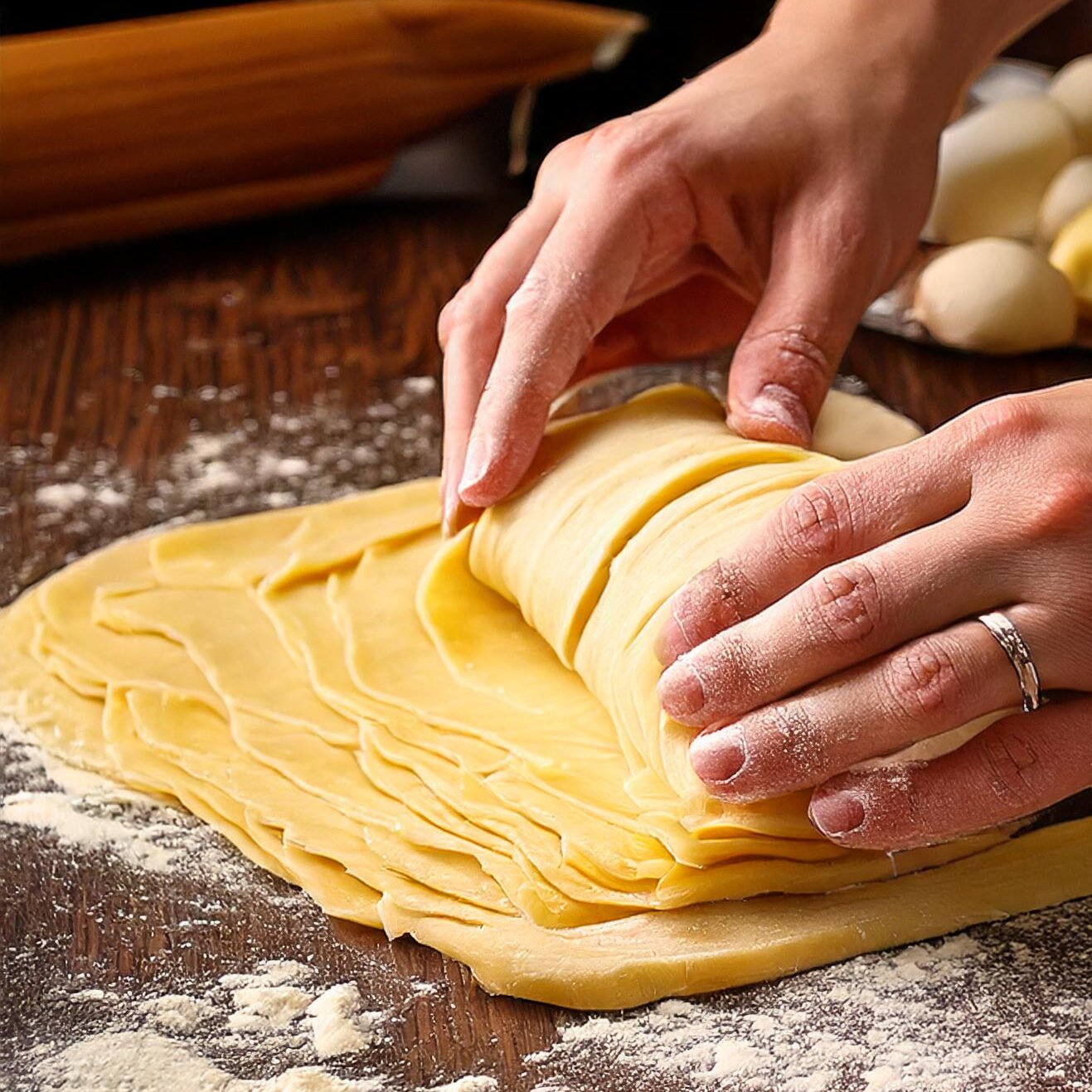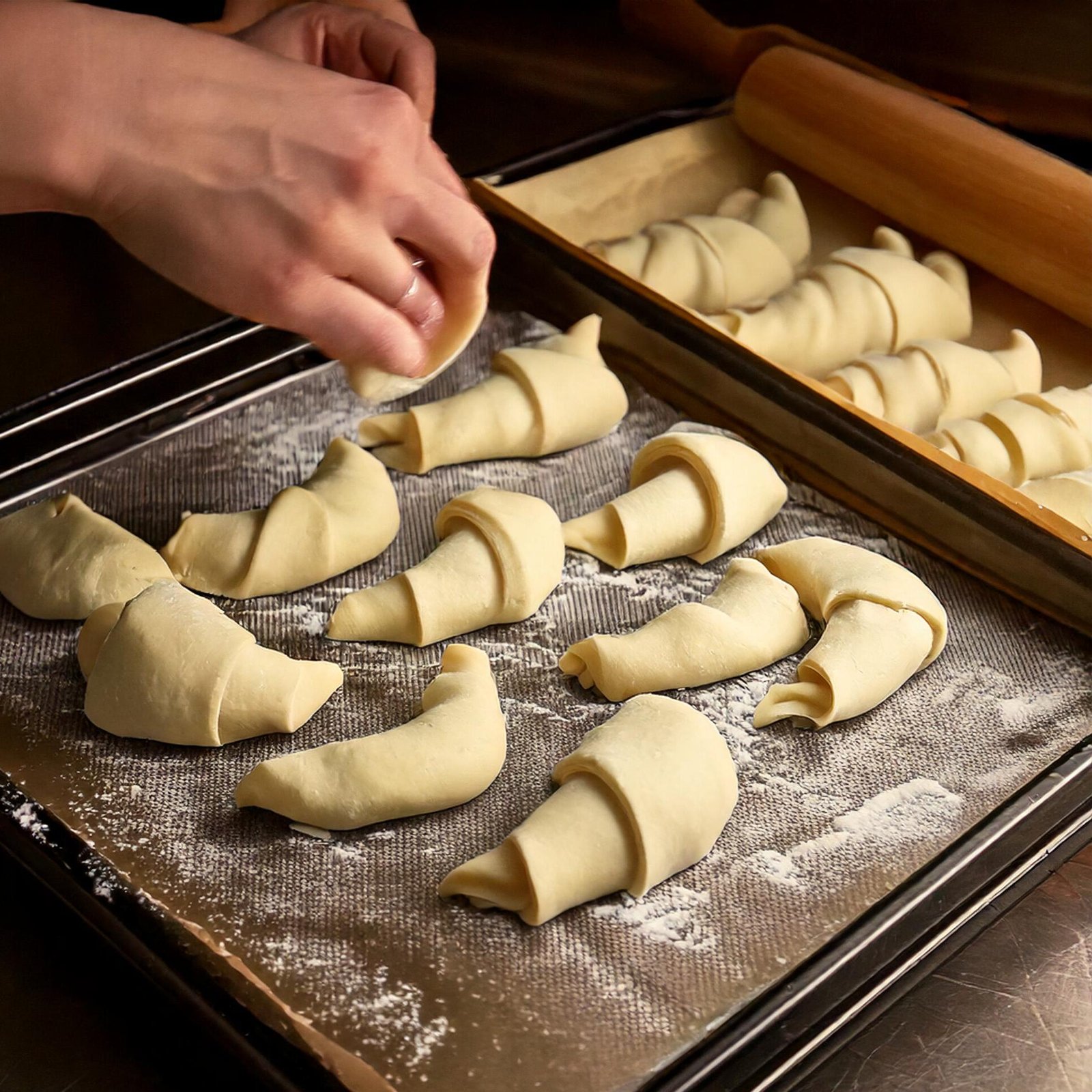Swiss pastries, especially Gipfeli, hold a special place in the hearts of both locals and visitors to Switzerland. These crescent-shaped treats, often referred to as Swiss breakfast croissants, boast a slightly denser texture and a subtler buttery profile than their French counterparts. With this Swiss Gipfeli Recipe, you will learn how to create authentic, flaky Swiss rolls right in your own kitchen.
Introduction to this timeless classic
When it comes to savoring Swiss pastries, the Swiss Gipfeli stands out as a timeless favorite. Similar in shape to the croissant, these homemade Gipfeli differ in texture and flavor, offering a distinctly Swiss twist. By following this Swiss Gipfeli Recipe, you will discover the techniques, ingredients, and tips needed to replicate these flaky Swiss rolls at home. Whether enjoyed at breakfast or as a midday treat, Swiss Gipfeli embody the cozy, comforting essence of Swiss baking traditions.

Why This Recipe Is Special
Understanding the Charm of Swiss Pastries
Switzerland’s culinary heritage boasts a variety of baked goods, but Gipfeli hold a special place. Unlike French croissants, Swiss breakfast croissants (Gipfeli) have a denser, slightly less buttery profile. This unique character makes them perfect for pairing with jam, cheese, or ham. By trying this Swiss Gipfeli Recipe, you immerse yourself in a centuries-old tradition, bringing the flavors and aromas of a Swiss bakery right into your kitchen.
Benefits of Making Homemade Gipfeli
- Control Over Quality: By making your flaky Swiss rolls at home, you can choose premium ingredients and avoid unnecessary additives.
- Customization: Fill your homemade Gipfeli with sweet or savory fillings to suit your preferences.
- Freshness and Flavor: Nothing beats the taste of a freshly baked, still-warm pastry. This Swiss Gipfeli Recipe ensures that each bite is tender and fragrant.
Key Ingredients for an Authentic Gipfeli
Selecting High-Quality Components for Your Flaky Swiss Rolls
The simplicity of the Swiss Gipfeli Recipe calls for top-notch ingredients. Since the dough and butter form the heart of these Swiss pastries, invest in quality for the best results. To ensure the finest flavor and texture for your Swiss Gipfeli Recipe, choose the best available ingredients. For more information on selecting premium flour, consider the guidelines provided by King Arthur Baking to guarantee that your homemade Gipfeli have a consistently tender crumb and delightful taste.
Core Ingredients:
- All-Purpose Flour (500g): Provides structure and elasticity for your homemade Gipfeli. Opt for unbleached, high-quality flour.
- Unsalted Butter (250g): The key to achieving flaky layers in your Swiss breakfast croissants. A high-fat, cold butter is crucial.
- Milk (200ml): Adds richness and softness to the dough. Whole milk is ideal to create that authentic Swiss pastries texture.
- Sugar (2 tbsp): Adds a subtle sweetness, ensuring your Swiss Gipfeli Recipe has a pleasant flavor.
- Active Dry Yeast (7g): Ensures the dough rises, giving the pastry its light, layered structure.
- Salt (1 tsp): Balances sweetness, enhancing the overall taste of your flaky Swiss rolls.
- Egg (1 large): Used for glazing, giving your homemade Gipfeli their signature golden-brown finish.
Optional Fillings and Variations
Sweet Fillings:
- Chocolate chips
- Almond paste
- Fruit jam (apricot or raspberry)
Savory Fillings:
- Swiss cheese (e.g., Emmental or Gruyère)
- Ham
- Spinach and feta
By adding these fillings, you enhance the Swiss Gipfeli Recipe to cater to various palates, turning your Swiss pastries into versatile treats suitable for any meal.
Preparing the Dough for Your Homemade Gipfeli
Making the dough is the foundation of any successful Swiss Gipfeli Recipe. By following these steps, you ensure the perfect base for your flaky Swiss rolls.

First : Activate the Yeast
- Warm the milk to about 37–40°C (100–105°F).
- Add sugar and yeast, stirring gently.
- Let the mixture sit for 5–10 minutes until it becomes frothy, indicating active yeast.
Second: Combine Dry Ingredients
- In a large bowl, whisk together flour and salt.
- Make a well in the center for the yeast mixture.
Third: Forming the Dough
- Pour the yeast mixture into the flour well.
- Gently mix until a rough dough forms.
- Transfer the dough to a lightly floured surface and knead for 8–10 minutes until smooth and elastic.
Fourth: First Rise
- Place the dough in a lightly oiled bowl and cover it.
- Let it rest in a warm, draft-free place for 1–2 hours or until doubled in size.
- Properly risen dough sets the stage for a flawless lamination, essential in the Swiss Gipfeli Recipe.
Laminating the Dough to Create Flaky Swiss Rolls
How Lamination Shapes the Swiss Breakfast Croissants Texture
Lamination is the process of incorporating butter into the dough to create multiple flaky layers characteristic of Swiss pastries. This step distinguishes Gipfeli from regular bread rolls, resulting in the signature crisp exterior and tender interior of your homemade Gipfeli.
If you’re new to pastry lamination, you can broaden your skills by visiting The Kitchn for expert insights on proper folding methods. Mastering this step ensures the characteristic layers that define authentic Swiss pastries, resulting in truly remarkable homemade Gipfeli.
1: Prepare the Butter Block
- Place cold butter between two sheets of parchment paper.
- Flatten it into a thin, rectangular sheet with a rolling pin.
- Keep the butter cold but pliable—chill it briefly if it softens too much.
2: Roll Out the Dough
- Once the dough has risen, roll it into a large rectangle, about twice the size of your butter block.
3: Encase the Butter
- Place the butter block in the center of the dough.
- Fold the dough edges over the butter, sealing it completely.
- Ensure no butter leaks out, as clean lamination is crucial for achieving ideal flaky Swiss rolls.
4: The Rolling and Folding Process
- Gently roll the dough into a long rectangle.
- Fold it into thirds (like a letter).
- Rotate the dough 90 degrees and repeat the roll-and-fold process 2–3 more times, chilling the dough for 20–30 minutes between folds.
- These repeated folds create the layers that define a perfect Swiss Gipfeli Recipe.
Shaping and Proofing: Mastering the Swiss Breakfast Croissants Form
Proper shaping ensures your homemade Gipfeli look and bake evenly. This section breaks down the process step-by-step, helping you form the classic Swiss pastries shape.

Rolling Out the Laminated Dough
- After the final fold and chill, roll the dough into a rectangle about 5mm (¼ inch) thick.
- Keep edges straight and even for uniform portions.
Cutting the dough into Triangles
- Using a sharp knife or pastry cutter, divide the dough into long triangles, about 10–12 cm (4–5 inches) wide at the base.
- These triangles will give your flaky Swiss rolls their signature crescent form.
Adding Fillings (Optional)
- Place a small amount of sweet or savory filling at the base of each triangle if desired.
- Avoid overfilling to prevent leaks during baking.
Rolling the Triangles
- Start rolling from the wide base toward the pointed tip.
- Tuck the tip underneath to maintain shape during baking.
- Gently curve the rolled pastry into a crescent, creating the iconic form of Swiss breakfast croissants.
Proofing the Shaped Gipfeli
- Transfer shaped pastries to a parchment-lined baking sheet.
- Cover loosely with a clean kitchen towel or plastic wrap to prevent drying.
- Proof for about 45–60 minutes in a warm, draft-free area (26–30°C / 80–85°F) until nearly doubled in size.
- Proper proofing ensures light, airy Swiss pastries and highlights the layers formed by lamination.
Baking the Perfect swiss pastry
Baking brings your hard work to fruition. Follow these steps to ensure a golden, crispy exterior and tender interior that defines an authentic Swiss Gipfeli Recipe.
Preheating the Oven
- Preheat your oven to 200°C (390°F) for a conventional oven or 180°C (356°F) for a fan-assisted oven.
- A properly heated oven ensures even baking and the right texture for your homemade Gipfeli.
Applying the Egg Wash
- Beat one egg with a tablespoon of milk or water.
- Gently brush the surface of each pastry, ensuring they develop a glossy, golden-brown finish.
- This egg wash step is integral to achieving that appetizing appearance associated with Swiss pastries.
Baking Time
- Place the pastries in the preheated oven.
- Bake for 15–20 minutes or until evenly golden and crisp.
- Rotate the baking sheet halfway through to ensure uniform coloration.
Checking for Doneness
- Properly baked Swiss Gipfeli should feel light and sound hollow when tapped at the bottom.
- The layers should be visible, and the pastry should have a delicate, flaky crumb.
Serving, Storing, and Enhancing Your Swiss Pastries
Presenting Your Homemade Gipfeli
Enjoy your Swiss breakfast croissants slightly warm to experience their full flavor and texture. Serve them with butter, jam, or honey, or pair them with coffee or hot chocolate for an authentic Swiss morning.

For inspiration on enjoying your freshly baked Gipfeli like a local, explore Swiss culinary traditions at MySwitzerland.com. This resource offers pairing ideas, insights into local dairy products, and tips on selecting the perfect accompaniments to elevate your Swiss breakfast croissants experience.
Storing Your Flaky Swiss Rolls
- Short-Term Storage: Keep leftover pastries in an airtight container at room temperature for up to 2 days.
- Reheating: Warm them in a preheated oven at 180°C (350°F) for 5–7 minutes to restore crispness. Avoid microwaving, as it makes them soggy.
Freezing for Future Enjoyment
- Freeze Unbaked Dough: Shape the pastries, freeze them on a tray, then store in freezer-safe bags.
- Bake-On-Demand: Thaw overnight, proof, and bake as needed, ensuring fresh homemade Gipfeli anytime.
FAQs on This
Frequently Asked Questions About Swiss Pastries
Q1: Can I use margarine instead of butter for this Swiss Gipfeli Recipe?
A1: While margarine is possible, butter provides superior flavor and authentic flakiness. For the best Swiss pastries results, stick to high-quality butter.
Q2: How do these differ from French croissants?
A2: Swiss breakfast croissants (Gipfeli) are denser, slightly less buttery, and reflect Swiss baking traditions. They’re a unique treat, not just a croissant clone.
Q3: How can I proof the dough in a cold kitchen?
A3: Place the dough in a turned-off oven with a bowl of hot water. This creates a warm, humid environment that helps the yeast activate properly.
Q4: Do I have to laminate the dough?
A4: Laminating is essential for creating the flaky layers associated with flaky Swiss rolls. Skipping this step compromises the texture and authenticity.
Q5: Can I use whole wheat flour instead of all-purpose flour?
A5: Partial substitution is possible, but it may affect the delicate, flaky texture. Experiment gradually to maintain the character of this Swiss Gipfeli Recipe.
Q6: Why did my pastries lose their shape in the oven?
A6: Over-proofing or insufficient chilling during the lamination process can cause spreading. Monitor proofing times and dough temperature carefully.
Conclusion: Enjoying Your Homemade Gipfeli
By following this Swiss Gipfeli Recipe, you embrace a longstanding Swiss tradition. From selecting premium ingredients and mastering lamination to shaping, proofing, and baking, each step contributes to creating flawless homemade Gipfeli.
As you serve your flaky Swiss rolls fresh from the oven, relish the warm, buttery layers and subtle sweetness that define Swiss pastries. With practice, patience, and thoughtful attention to detail, you will consistently bake Swiss breakfast croissants that impress family and friends. Enjoy the journey, and savor the rewarding results of your efforts.
